Home Entertainment Blog Archive
Brought to you by your friendly, opinionated, Home Entertainment and Technology writer, Stephen DawsonHere I report, discuss, whinge or argue on matters related to high fidelity, home entertainment equipment and the discs and signals that feed them. Since this Blog is hand-coded (I like TextPad), there are no comments facilities. But feel free to email me at scdawson [at] hifi-writer.com. I will try to respond, either personally or by posting here emails I consider of interest. I shall assume that emails sent to me here can be freely posted by me unless you state otherwise.
This archive is for an uncertain period commencing Thursday, 10 September 2009
 I have just been looking at the second disc of the brilliant 'Ultimate Collector's Edition' Blu-ray version of Woodstock: 3 days of peace and music. One of the extras on this disc is a five minute featurette called 'The Museum at Bethel Woods: The story of the Sixties & Woodstock'. This is presented in 1080i60 format (VC1 encoded), but it doesn't look sharp enough to justify that HD format.
I have just been looking at the second disc of the brilliant 'Ultimate Collector's Edition' Blu-ray version of Woodstock: 3 days of peace and music. One of the extras on this disc is a five minute featurette called 'The Museum at Bethel Woods: The story of the Sixties & Woodstock'. This is presented in 1080i60 format (VC1 encoded), but it doesn't look sharp enough to justify that HD format.
I'm 90% sure that it has been upconverted from 480i60. And that the conversion was an astonishingly poor job.
Obviously I'm far more familiar with issues of converting 576i50 to 1080i50, so it was startling to see an obvious marker of poor quality of the kind with which I'm familiar. The picture to the right is a full frame (which I shrunk, obviously), with an detail of the frame in the box. That detail was not scaled by me, so that's what you would see on a full high definition display. Notice the horizontal lines near the top and bottom of the characters: that is an artefact of poor deinterlacing and scaling. I see it all the time with cheap high definition set top boxes. They apply a simple bobbing style deinterlacing technique to SD (ie. 576i50) transmissions, then scale the result up to 1080i50, producing those lines.
 It actually looks somewhat like the
Chroma Upsampling Error except that it affects not the colour channels but the luminance one.
It actually looks somewhat like the
Chroma Upsampling Error except that it affects not the colour channels but the luminance one.
The picture to the right is from a photo of a display produced by one of those low quality HDTV receivers, upsampling SDTV. There is more on this here, including a picture of how this kind of thing is supposed to look. It seems to appear most commonly when that bobbing deinterlacing is applied to progressive scan material (as still graphics must always be, for course).
But that's a cheap consumer-level TV receiver. What's surprising is that this should happen on professional level upscaling performance for video release on Blu-ray. And, of course, had this been presented on the disc in 480i60 format, the best of consumer technology -- pretty good stuff these days in a lot of cases -- could have been applied to upscaling the picture. The results would have been better than as delivered on this disc. The video on the disc is irrepairably damaged. Nothing you can do can significantly improve it.
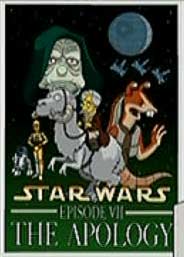 The Simpsons - Season 21 commences - Wednesday, 14 October 2009, 9:43 am
The Simpsons - Season 21 commences - Wednesday, 14 October 2009, 9:43 am
Season 21 of The Simpsons started in Australia last night. Episode 1, 'Homer the Whopper', had a clever premise in which Comic Book Guy had penned his own series of comics which he hadn't published for fear of scorn from fellow CBGs. However he was convinced to do so, and instantly a movie version went into production from 'Ginormous Pictures'.
The graphic to the right is the purpose of this post: it appeared to the side of the 'Ginormous Pictures' entry. Did everyone catch it?
Regarding my earlier post (two down) on possible differences between US and Australian Blu-ray discs for quality, Sandra has written to me:
I was also present the night John talks of. There is an alternate hypothesis to encoding variations or imagination to explain these perceived differences. Is it possible that physical variations in the disks arising from differences blu ray disk production quality control standards or practices could lead to slight differences which are material for players i.e. which lead to visible differences for the user? I know the "digital is digital" argument regards 1's and 0's but it seems clear that some brand new disks sometimes have playability issues on some players. Could it also be possible that the tiniest variations in physical disks could result in slightly visible differences at the player level?This is an interesting theory, but I have strong doubts about it.Is this possibility being suggested in the following white paper from quality control specialists in the blueray production process? See:
http://www.media-tech.net/fileadmin/templates/BD_News/OTO222_p30-33_whitepaper.pdfOn p2 under the heading "Coating thickness uniformity: local defects" they state (2nd para):"Bumps in the coating layer do not directly affect the signal quality. However, they may cause optical aberrations that lead to focus and tracking errors."One does not have to understand all the details of this highly technical paper, to get the point that bluray production is FAR more technically demanding than is standard DVD. This is after all new technology. I do hope I am wrong, as the implications are gruesome. I cannot help but wonder whether occasionaly the pressures on increasing yields could cause production houses to drop standards, or whether just natural random variation in the physical disk, even within agreed tolerances, can cause some players to playback ever so slightly differently even the same encode?In any case I agree with you that we need to do further comparisons, on the same gear, blind, to see if any variances can be repeatedly detected.
In the mean time, from your knowledge of bluray production and players, do you think this alternative hypothesis i.e. we just happened to strike a "dud" Australian disk, at all possible?
There are two ways that data reading difficulties could, arguably, feed into performance. One is if the data itself is corrupted as a result, and clearly this could have major implications. This way is not in dispute by anyone, and I will return to it in a moment.
A more subtle way that is sometimes raised is that the data ends up not being corrupted, but only because the equipment is working harder at correcting the data. That in itself is said to feed back into the reproduction chain in some way, reducing quality.
I've always thought that this latter argument is not very strong at all, since the effects (for example, greater power draw by the processing chips) would be of a magnitude similar to other pseudo-scientific nostrums peddled in the hifi and home theatre arenas (eg. the £500. P.W.B. Quantum Clip).
So let us return to corrupted data. There is a major disconnect between the claimed corruption of data drawn from a Blu-ray disc, and the alleged effects on the screen. Intuitively it would seem that, say, the loss of some proportion of the data would translate to the loss of some proportion of the picture, perhaps fine detail or colour fidelity.
That's how things work in analogue systems. But modern digital stuff does not work like that.
The data on a Blu-ray disc is not an analogue of the original signal. Through the compression systems it has been dismantled and repackaged in a completely different way that lacks all proportion to the original signal. Ultimately those proportions will be restored (more or less, because the compression is lossy), but while the data is being laid down on the disc, while it resides on the disc, and while it is being read from the disc, it has no apparent relationship to the original data, except via advanced mathematical transformations. Misplacing bits beyond the capabilities of the system to correct them will result in quite unpredictable errors.
When it comes to reading the disc, a significant number of read errors will cause the signal reconstruction to simply fail. What you will get is not subtle loss of detail, but gross errors such as macro blocking, dropped frames and even total signal loss.
That is how Blu-ray (and DVD) signal problems manifest. Not in loss of sharpness, detail, contrast and 'life' in the picture.
Warner Bros has released a bunch of new Blu-rays covering legacy titles (don't worry, new titles are coming too: Harry Potter and the Half Blood Prince will be available on Blu-ray from 18 November, and The Hangover from 25 November).
Amongst them are the Mel Gibson movie Payback, and the Oliver Stone classic, Natural Born Killers. Payback is provided in two versions: the original 1999 theatrical release, and the 2006 Director's Cut. This is a rare DC, being significantly shorter than the original, and apparently much darker. Both are on the one disc, and are so different to each other than they are entirely different encodes, rather than having seamless branching employed to stitch together the two versions (aside from anything else, their colour palettes are very different).
As it happens, Natural Born Killers was released on Blu-ray several months ago, so the new one is actually the Director's Cut, and is several minutes longer. The box is headed 'Original Uncut Version'. The changes are outlined here.
These, also, are very different encodes, for reasons which aren't clear. I used BDInfo 0.5.2 and 0.5.3 to capture video bitrate graphs from the two versions and placed the graphs on the same scale as an animation. You are getting a lot more bits in the original release. It will be interesting to see if there are any visible differences in the picture quality.
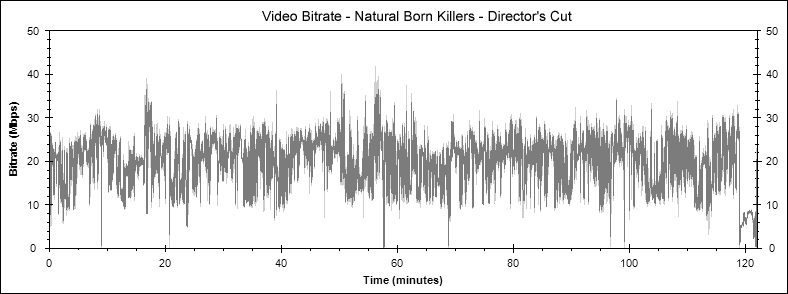
Yesterday I received a very interesting email from a reader, headed as shown above. The matters raised will be, I think, of interest to other readers on this Blog, so I'm answering it here. First, here's the email (lighted edited for grammar):
Hi, while comparing Blu-ray players and HDMI cables last night we (4 of us) discovered while using The Fifth Element Blu-ray as a reference (which we had 2 copies of) that there was a significant difference between them. One of the disks was a American import, the other an Aussie, both were the remastered versions.The American version was clearly sharper, more detailed, better contrast and had just more life to the picture, discussing this further one of the group said this was not the first time he had witnessed this, and went on to say he saw similar improvements on other Blu-rays such as The Dark Knight Region A over the B version .
We were using some pretty good gear, and whilst we could see improvements in players and then HDMI cables, the improvement in software was also significant.
This is to me terribly frustrating as I do not want to start replacing my Aussie Blu-rays for American ones. Would you be able to find out any info on this if possible please I would really appreciate it.
Here's a list of the visual equipment :-
JVC HD1 1080p projector
Oz Theatre screens Majestic 110 inch
Sony BDP-S1E
Fully light controlled room (dark walls and ceiling etc)Compared equipment:-
OPPO BDP 83 Blu-ray
Sony 5000 ES Blu-ray
Kordz master reference 7m HDMI cableRegards John
There are several issues here, but I'll start with the last concern: whether John should replace his Australian Blu-ray discs for American ones. The answer is: sometimes. But only if there really is a significant difference, only if it is the US version that is significantly better than the Australian version, and only if he has a player which will work with the US version.
If there are significant differences, I would generally expect that to be because the actual encoding of the data is different (different codec, for example, or different video bitrate). That would generally be because different companies have produced the discs for the different parts of the world, so these discs are more likely to be region coded. Obviously, an Oppo BDP-83 Blu-ray player purchased in Australia is likely to be fitted out to play discs from other regions, but few other players can do this.
In the specific cases mentioned -- The Fifth Element and The Dark Knight -- the US versions are not region coded. They will play happily in any player in the world.
Now let us assume for a moment that the US versions of these two movies do look better than the Australian versions, that does not mean that US Blu-rays in general look better than Australian ones. If the Blu-ray versions of all movies look different in their US and Australian versions, then the default assumption would be that of the ones for which a 'this is better than that' judgement could be made, in roughly half the cases the Australian version would look better than the US version.
Consider a gross example: the Australian version of Watchmen comes from Paramount with a much higher bitrate MPEG4 AVC transfer in Australia, than the US Warner Bros VC1 version. However the US version is the longer Director's Cut, so there's a tradeoff.
Now we come to the specifics of the claims for these two movies. I have written extensively about The Fifth Element in my review of the Australian version here. I have written extensively about the differences and similarities between this and the two US versions here, finishing it off quite conclusively, I think, here. I believe that in these posts I establish that the video in the Australian version released by Sony and the remastered US version is identical. Having said that, I have been advised by Sony that it has disposed of distributorship, at least in Australia, for this movie. I just checked and this movie does not appear to be available in either DVD or Blu-ray format from any of the major on-line Australian disc retailers (DVD Orchard, EzyDVD, DVD Crave, Atlantic DVD, DVD Downunder, Devoted DVD). So if you want this movie, for the moment you're going to have to buy from overseas.
As for The Dark Knight (my review of which is here), I invite readers to compare scans of both the Australian and US versions of this disc which were conducted using the tool BDInfo. These are on the Unofficial Blu-ray Audio and Video Specifications Threads, hosted at the AVS Forum. Those two posts show that both versions of this disc have exactly the same average video bitrate. From my experience with Warner Bros titles, to me that means that these are bit for bit identical copies. I note that the average bitrate for the English language Dolby TrueHD tracks is also identical. So the only difference seems to be the additional streams in the Australian version, adding a number of audio and subtitle languages.
So, are there actual visible differences between the US and Australian versions of these two movies? People like me are inclined to say 'No'. If the video streams are identical, then they should be decoded identically on any given player. So I'm inclined to think that the differences John reports are imaginary. It's the same phenomenon that can lead people to think that putting a plain piece of cardboard under one leg of a couch in your listening room can make your system sound better.
I suppose that the additional audio and subtitles streams included in the Australian version of The Dark Knight could, in some way, interfere with a player's performance in extracting data from the disc, since there is a bit more of it, but it doesn't seem likely. In any case, it is the US version of The Fifth Element that has the extra audio data, so such an effect should be around the other way with this movie.
I have previously received a report of alleged inferior performance of the Australian version of The Fifth Element, so perhaps there is some other version floating around out there. Unless proven, though, I'll stick with the opinion that the differences apparent between the two versions (and, the differences between competent HDMI cables) are imaginary. And I'll remain of that opinion until a well-conducted, statistically significant, double blind trial is conducted showing otherwise, and is successfully repeated a couple of times.
Whenever a new format appears, we enthusiasts wonder: 'Will my favourite items appear in this format. If so, how long will I have to wait?' I've been through this when the CD came in, then the DVD. In both cases, nearly everything I liked, no matter how obscure, eventually made it into the format.
I wondered this when SACD and DVD Audio were introduced. In both cases, nearly nothing that I liked appeared in the new formats.
So now we've got Blu-ray. There are now about a thousand titles available in Australia, or coming very soon. Those who enjoy the most recent movies are well served, and those who enjoy some of the classics, particularly from Warner Bros and MGM are also well served. But what if you want some of the classy independent and art-house stuff which has appeared over the past dozen years?
Dendy (part of Icon Home Entertainment) comes to the rescue here, with its excellent back catalogue. For release on 4 November will be (IMDB rating in bracket):
- Amelie (properly, Le fabuleux destin d'Amélie Poulain - 8.6)
- The Blair Witch Project (6.2)
- Emma (6.8)
- Man on the Moon (7.4)
- The Motorcycle Diaries (properly, Diarios de motocicleta - 7.9)
- Once Were Warriors (7.9)
- The Piano (7.5)
- Scream (7.2), and
- The World's Fastest Indian (8.0)
- Becoming Jane (7.0)
- Black Robe (7.2)
- Brassed Off (7.1)
- Death Defying Acts (5.9)
- Good Night, and Good Luck (7.7)
- Mambo Italiano (6.6)
- Oyster Farmer (6.7)
- Strange Bedfellows (6.6)
- Super Size Me (7.6)
- Volver (7.7), and
- Two Hands (7.0)
Look at the following graph. It shows the frequency balance of a musical section in a 1951 cartoon, 'Symphony in Slang', which appears on the Warner Bros Blu-ray release of An American in Paris.
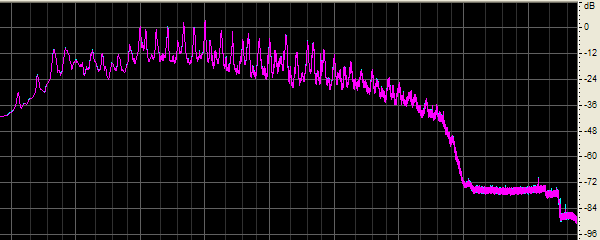
Whoops! I cut off the bottom scale! Well, take a guess. What are those divisions? We're talking 1950s here, so don't be too demanding.
Here's the answer: the thicker vertical lines mark, from the left, 55 hertz, 110, 220, 440, 880, 1,760, 3,520, 7,040 and 14,080 hertz. That's because of 'The Academy Curve', an audio standard settled upon in 1938 by the Academy of Motion Picture Arts and Sciences. This frequency response restriction was employed to limit the noise from optical soundtracks and was maintained in movies up until the early 1950s. As you can see, the high frequencies above about 5.5kHz are simply not there at all.
I used this cartoon, rather than the movie, because in the latter it's clear that some attempt has been made to resurrect its higher frequencies. But had you gone to the cinema back in 1951 to see the movie, Academy Sound is what you would have heard, even for the movie.
CinemaSquid has drawn my attention to a report that the US Federal Trade Commission has set rules requiring 'Consumer-generated media' 'to disclose if they are being compensated by a manufacturer, advertiser, or service provider when they review an item'.
Apparently Consumer-generated media are bloggers. If you fail to disclose, you could be fined up to $US11,000.
It will be interesting to see how this works across jurisdictions. I am in Australia, writing primarily about Australian stuff, but my website is hosted by a US company (Hosting Matters), and for all I know it keeps its servers somewhere else in the world.
Well, I get paid for my reviews. But by the publications for which I write, not the equipment suppliers. I don't get to keep the stuff I review (I'd be very, very rich indeed if I did, since I estimate I review about $AUS200,000 worth of stuff each year). I do on rare occasions buy equipment after the event at rather better than retail prices.
Various companies also fly me hither and thither, which tends to cost me since it means little or no productive writing at the time. Full disclosures here.
As to the substance of these legal changes, I am not happy.
These kinds of actions are the sorts of things governments do to be seen to be doing something. If the aim is to discourage the writing of incorrect things, then this can have only the slightest of effects because corruption is just one of many causes of false statements. Others, not so readily subject to regulation, are self-delusion, ideology and so on.
I don't like this at all. I hate government regulation, especially when it impinges upon liberties such as free expression. The correct punishment for a corrupt blogger should be explosure and the derision of all. As it should be for those who write blatantly false material for other, non-pecuniary, reasons.
But, then, I'm very close to a free speech absolutist.
UPDATE (Friday, 9 October 2009, 12:43 pm): One of my editors, Greg Borrowman from Australian HI-FI, disagrees, and makes some interesting points:
I'm with you on the less government control the better, but where do you draw the line?Advertisers in the US are now paying bloggers to make statements and claims about their products that are untrue, but because said bloggers appear to ordinary consumers to be 'ordinary consumers just like them, and completely impartial', those ordinary consumers are more likely to believe such claims than they would be if the same claims were made in a commercial environment. (And the advertisers aren't liable at law for the misinformation.) It's not exactly a small market either: US advertisers paid bloggers US$1.35 billion in 2007!
I have read so much complete bullshit written by bloggers about hi-fi products, where they have been wrong about materials/drivers/country of origin/person who designed them/other people who own them etc etc etc that it gets very depressing... especially when such wrong information is then recycled as an 'advertisement' and in press releases by local distributors!
I plugged in a Samsung BDP-1600 Blu-ray player this evening, whereupon it automatically asked if it could upgrade itself from version 1.0x firmware to 2.04. As is my practice, I told it to go ahead and went and did something else. I don't know what, if anything, the firmware repaired. But when it had finished it had access to You Tube videos. Very clever.
I just wrote a 650 word email to Twentienth Century Fox Home Entertainment. My editor, Jez Ford, used just three words to basically say the same thing in response: 'NDAs are evil'.
Trying to keep in contact with the various distributors of Blu-ray discs has been difficult. From my point of view -- largely because they are so responsive and helpful -- the best companies are Warner Bros, Paramount, Roadshow Entertainment and Disney.
The worst has been Universal Pictures. Most of the time they don't even respond to email, and review discs are few and far between.
Sony Pictures Home Entertainment and Twentieth Century Fox have been variable. I am loathe to criticise them because they both came to my rescue, three years ago, with Blu-ray discs when I had the first couple of players heading my way, and nothing to play on them. But over the last year or so, they have been quite unresponsive to my email. Nice enough on the phone, but little happens.
So once again I got into contact with the latter today, since I need a packshot for my recent Blu-ray vs DVD comparions of The Transporter. It wasn't available through the company's online press office.
I was heartened to discover that one of the excellent PR people from Paramount was now with Fox. Unfortunately, new rules (not his fault) have been put in place by Fox corporate, technically 'TWENTIETH CENTURY FOX HOME ENTERTAINMENT LLC, with offices at 2121 Avenue of the Stars, Los Angeles, California 90064', if I can quote from the 'CONFIDENTIALITY AND CONTENT PROTECTION AGREEMENT' it has disagreeably exuded.
Apparently, one can only receive review copies of Fox Blu-ray discs and DVDs if one signs this agreement.
Had I signed this agreement, I would not have been able to even mention on this Blog that I had signed the agreement unless I had written permission from Fox to do so! Don't believe me? The 130 word definition of 'CONFIDENTIAL INFORMATION' says, in part:
Confidential Information includes, for example and without limitation, information, techniques, and processes related to the creation, promotion, marketing, selling, and distribution of Fox's products, including without limitation creative processes, content protection measures, marketing plans, customer and supplier identities, pricing, other competitive information, the status of discussions or negotiations between Fox and Recipient, and the terms of this Agreement or any other agreement between Fox and Recipient. Confidential Information can be in tangible or electronic form or conveyed verbally.I'm quoting this at length, because anyone who actually signs it probably won't be able to. Don't believe me? Clause 2(a) says:
Recipient shall hold Confidential Information in trust and confidence on behalf of Fox. Recipient shall not disclose Confidential Information to any third party, except as specifically approved in advance in writing by Fox.
No journalist should sign this. The preamble says:
In connection with the Purpose, Recipient may acquire highly sensitive and valuable information and materials from Fox, and both parties wish to ensure that these information and materials are protected and kept secure in their mutual business interests.As I wrote to Fox, decling to sign:
In fact, the job of the Recipient is to provide interesting and useful information to the readers of the publication. Sometimes (virtually never in my case) that may not be in Fox's business interest.But it would have been easier to say what Jez said: 'NDAs are evil!'
Meanwhile, should you read in your local newspaper or a magazine or on a website a review of a DVD or a Blu-ray disc from Fox, you should perhaps query the publication as to whether it is bound by a 'CONFIDENTIALITY AND CONTENT PROTECTION AGREEMENT'.

Madman Entertainment today sent me the Blu-ray versions of Afro Samurai and Afro Samurai: Resurrection. Both look like they are going to be very interesting.
The reason for this Blog post is just to chuckle over an interesting little quirk with the former disc. It is coded Region B, which means it will work in players from Australia and Europe, but not in those from elsewhere The way I check the region coding is by forcing the region code on my computer to Region A, then Region C, and finally Region B. This disc would only play when I set the code to Region B. But if it was set to either Region A or C, the graphic above was displayed: 'This Blu-ray disc will playback on Region A players only'.
My guess: the disc was prepared in the US for Madman, and the authoring house forgot to change the graphic. Madman would probably never notice, because they'd do all their quality control in a Region B player, so the rejection screen would never appear.
Actually, aside from the region coding issue, this disc seems very similar indeed to the US release (which is region coded 'A'). They have the same playlist file name, and the same actual transport stream file names. They use the same video codec and have the same average video bitrate. They both lack subtitles. They also have the same average audio bitrate for their Dolby TrueHD track.
Oddly, though, they differ in their two channel Dolby Digital audio track: the US version gets 640kbps while the Australian version gets 448kbps.
So just another of those amusing quirks one comes across.
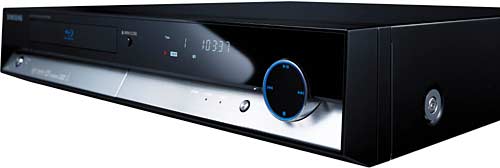 Over the last three years I have developed a number of standard measurements and tests that I conduct on Blu-ray players, and now I have a spreadsheet with the details for more than twenty players recorded. This includes such things as timing for starting play on certain discs, audio handling, deinterlacing performance and so forth.
Over the last three years I have developed a number of standard measurements and tests that I conduct on Blu-ray players, and now I have a spreadsheet with the details for more than twenty players recorded. This includes such things as timing for starting play on certain discs, audio handling, deinterlacing performance and so forth.
Back in late 2006 and early 2007 I reviewed the first three Blu-ray players available in Australia: the Samsung BD-P1000, the Panasonic DMP-BD10 and the Pioneer BDP-LX70. It would have been nice to apply the same tests to those three players, but at the time I hadn't thought them out, nor did I even have the discs I used to do them.
So, I wonder, do any of you out there, preferably local to Canberra, ACT, have one of these models that you would care to lend to me for a day or so?
 The latest issue of
Australian HI-FI magazine carries my reviews of the Blu-ray versions of
Sleeping Beauty and Woodstock: 3 Days of Peace and Music. As I note in the latter review:
The latest issue of
Australian HI-FI magazine carries my reviews of the Blu-ray versions of
Sleeping Beauty and Woodstock: 3 Days of Peace and Music. As I note in the latter review:
No chapter listing is provided with this version of the disc, and the 'Scene Selector' pop up is not all that clear. You can download a PDF of the track listing from my website, from the link on the front page at www.hifi-writer.com.I quite forgot about that, but I remembered this evening, so I've put a link on the front page. The 253kB PDF is here. When printed out, it should slip neatly under the clips inside the Blu-ray case.
I was just trawling through Roadshow Entertainment's publicity website to get ahold of a packshot of A History of Violence for my forthcoming Blu-ray review, when I stumbled on the fact that Pulp Fiction is due for release by Roadshow in November. In view of the appalling state of the DVD, this is great news.
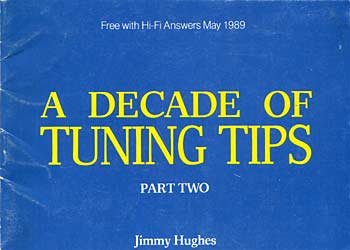 Perhaps 'the worst book ever written' was actually the second worst.
Perhaps 'the worst book ever written' was actually the second worst.
A while back I mentioned this little pamphlet, and promised to come back to it. Well, here goes. First, the claim by the author, Jimmy Hughes:
I have experienced every one of these techniques in practice, and can vouch for the effects produced.This is one reason why I am extremely cautious when it comes to subjective reviewing. And here is one of those techniques:
... put a small piece of plain paper or card (that is, a piece with no writing or printing on it) under one of the feet of any piece of equipment with an even number of support points. You can use this technique very successfully on audio and video equipment, as well as on larger objects like refrigerators. I achieved marvellous results by putting a piece of plain white card under one foot of my sofa and chairs --visitors have often been amazed when I've demonstrated the effect on the sound produced by removing the card from under my sofa, and they could not see what I was doing.I have this vision. Mr Hughes has some friends or acquaintances or relatives in his living room. He does something out of their sight and enthusiastically proclaims that -- surely!!! -- they can sense the muddiness and sheer lack of tunefulness that his music system now produces, compared to moments before. In the face of his certainty, and his child-like delight, who but a churlish individual such as me could disagree?
If you are thinking about giving this technique -- the effect of which Mr Hughes vouches for -- a whirl, do remember to make sure that the card you place under the foot of your sofa or chair does not have any writing on it. No one can say what the effects are if there is indeed some text imprinted on the surface. Permanent damage may result.
There can be no doubt that Manthropology is the worst book ever written. Its prose is of a lower standard than that of Jane Austen's Pride and Prejudice. It is shorter than the Holy Bible. It is less engrossing than the movie Terminator 2.
Can you dispute any of these clear facts?
If not, then on the author's own argument, his book is the worst.
His argument appears in an interview on Australian ABC Radio's 'Counterpoint' program on 14 September 2009, to which I have just finished listening. The thesis of his book is that 'every man in history, back to the dawn of the species, did everything better, faster, stronger and smarter than any man today.' Or so says his publisher's page.
In the interview the author, Peter McAllister (apparently 'a qualified palaeoanthropologist', which makes me depair for that science), argues his case. From memory:
- Rapper '50 Cent' can only remember 6,000 lines of verse, whereas Homer (the ancient, not the Simpson) could remember 30,000 and some Serbian of around a century ago could remember 350,000.
- David Beckham doesn't spend three or more hours each morning devoted to making himself pretty, unlike the Fulani tribemen of somewhere or other.
- A Neanderthal woman could beat Arnold Schwarzenegger in his prime in an arm wrestle.
- Homo Erectus had similar sized sockets to modern man on their limb bones, but thicker actual bones.
- Pygmies are better fathers than modern men because they spend 47% of their time with their kids.
For goodness sake, Neanderthals and members of Home Erectus aren't even the same species as us. You may as well complain about a modern man's swimming ability because he would be bested by a shark!
Go here to see my Blu-ray vs DVD comparison. A sample (DVD left, Blu-ray right):

Go here to see my Blu-ray vs DVD comparison. A sample (DVD left, Blu-ray right):
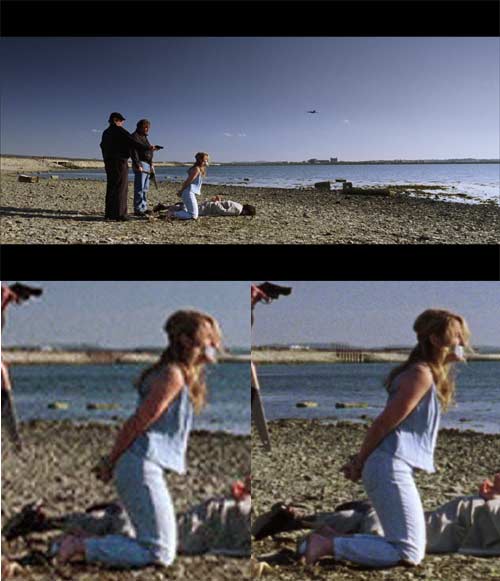
While in Japan I had an interesting discussion on whether or not one can hear the differences in cables. I am not in the 'can hear a difference' camp. To quote from one of my own articles:
The first and most obvious [explanation for claims that cables sound different] is that there are differences, and these listeners have the sufficiently acute hearing and refined listening experience to enable them to detect it. This has some unpleasant implications, though.Anyway, I suggested that the believers could make a handy $US1 million by participating in the James Randi Educational Foundation's Million Dollar Challenge. The usual response was made: a respected reviewer of equipment had tried to undertake the challenge, but they were unable to agree on a suitable protocol. Having returned, I've been checking this out.To understand this, you need to accept that a cable cannot improve sound. It is a passive device. At its best, an interconnect cable will transport the sound without any degradation at all. But if it did alter the signal in some way, that alteration must be a degradation.
So, next time you are in a hifi shop that offers to sell you cable A for $100, or for even better results, cable B for $200, consider what they are saying. They are saying that they will charge you $100 for a cable which they know to actually damage the signal!
First, I am somewhat of an extreme sceptic (aka skeptic) myself about a wide range of matters including, obviously, many aspects of high fidelity. Second, Randi's foundation really does offer a million bucks. It has the money in the bank, ready to go.
Third, I found a previously negotiated challenge on the Randi site which apparently fell through. The whole sorry saga is laid out under 'MICHAEL ANDA, Audio Critic'. Two things stood out for me about this: the Randi representative was, I think, needlessly aggressive about the matter, while the Anda chap appeared to have an unusually high level of self-regard. It never got to the point of any actual listening.
Fourth, I found an interesting blind test conducted outside the auspices of Randi's Million Dollar Challenge. This is well summarised in the first post on this thread, and the person who actually undertook the blind listening tests, Mike Lavigne, adds more detail in this post. In brief, the test was abandoned after seven valid trials. The results of trying to pick the cables: right, wrong, wrong, wrong, right, right, wrong. Apparently a seriously high-end system was employed. Lavigne felt very confident, before he donned the blindfold, that he could tell two sets of cables apart. He felt confident during the test that he was getting it right. But he wasn't. I have to admire this fellow's courage and integrity.
Fifth, well known Stereophile reviewer Michael Fremer was on the verge of undertaking the Challenge, but the whole thing fell apart. In brief, the thing started with some snarky comments by Randi about Pear Cable's Anjou range of speaker cables. These cost $US7,250 for a 12 foot (approx four metres) pair. Apparently Pear Cable were initially keen to provide a loaner for the test. Fremer and Randi were both keen. But Pear pulled out. At those prices, it wasn't surprising that neither Fremer nor Randi were prepared to actually pay for them.
Gizmodo has a useful, and fairly neutral (a least, with regard to Randi and Fremer), account of the matter. It lays the blame squarely on Pear Cable.
According to Fremer, James Randi proclaimed on his website 'that the "blowhard" Fremer would never take the challenge, that the matter was closed, and that it was time to move on to the next challenger.' Fremer says he responded on Randi's forums and Randi eventually, kind of, retreated.
At this point in the story, I was feeling pretty sorry for Fremer. I think he's probably wrong, and is most likely imagining any differences he claims to hear in cables, but that doesn't mean he's insincere, or a blowhard. I was thinking that Randi, after fifty years of exposing squirming 'psychics' and other practitioners of the paranormal, was getting a bit short tempered.
But now I think there was a misunderstanding. For what was printed on Randi's site (the link from Fremer's column no longer works) under the heading 'Blake Withdrawls from PEAR Cable Challenge' (sic) was an email from Adam Blake, the CEO of Pear Cables, which opened:
At the request of Michael Fremer, with whom we have been communicating regarding his challenging of your assertions regarding high-end audio cables, we would like to inform you directly of Pear Cable's decision to not participate in your claimed challenge.I don't know about you, but to me that at first glance read as though Blake was claiming that Fremer had withdrawn. The whole sentence does not say that, but that was my first impression. I strongly suspect that Randi may have inferred that meaning, resulting in his remark later in the same post:
Third – and most interesting – this retreat by Adam Blake effectively closes the current challenge, much to the relief of both Fremer and Blake, of course. Actually, I must admit that this was a rather clever way of squirming out of the huge dilemma in which these two blowhards found themselves.I think at the least both Fremer and Randi approached this in the beginning with good will. Fremer strongly believed that he would win the Challenge. Randi strongly believed he would not. Randi is highly suspicious of those who makes what he believes to be outlandish claims for the reasons outlined above, and over-reacted to a misinterpretation of the Blake letter.
As to whether cables make a difference in sound, all of this goes to prove ... well, precisely nothing.
Even the failure to notice a difference mentioned under 'Fourth' above doesn't prove anything. As correctly noted at certain places on that thread, the test failed to disclose any noticable differences by those participants alone in those conditions alone.
I have in my possession copies of articles showing unblind, followed by blind, tests of sound. The unblind tests had marked differences noted. The blind ones had no differences noted. Same people, same equipment.
There's a pattern here. People are convinced that there are differences. But every time they are put to a reasonably well conducted test, the differences disappear. This, in itself, proves nothing for the reasons already mentioned.
But it is suggestive.
Even more suggestive would be even one well-conducted double blind test of a controversial claim that went the other way; that showed that a difference could be discerned. If anyone knows of such a test, please let me know. Because until such a test becomes known, it would seem prudent to remain sceptical.
Go here to see my Blu-ray vs DVD comparison.
I was in Japan last week as a guest of Yamaha Music. Had a great time. Ate dinner at the restaurant which inspired Tarantino for the restaurant fight in Kill Bill Part 1. Saw some interesting products.
Yamaha has a truly superb home theatre room at its Hamamatsu headquarters, where it showed off its new RX-V2650 home theatre receiver and one of its new Blu-ray players (the latter seems to be based on Sharp hardware).
Also had a tour of the whirlwind woodwind factory tour, and a somewhat slower one of the upright piano factory. More details in due course.
Earlier in the week I remarked on the the live Pink Floyd release, 'Pulse', on DVD. You may recall that this has the surround soundtrack in two formats: 448kbps (the maximum specified for DVD) and 640kbps (the maximum specified for Dolby Digital in any format). I noted that:
my impression was that the 640kbps version was a decibel or two louder than the 448kbps version, so that would immediately invalidate any A-B comparison without a great deal of setting upI've finally finished playing with receivers of limited capability, so this morning I installed a rather nice Denon AVR-4310. This has rather fuller signal information screens than the low cost receivers, so I played one of these discs again.
Yes, the 640kbps version has a Dolby Digital Dialogue Normalization ('dialnorm') value of -4dB, which is a very common value for this. But the 448kbps version has a dialnorm of -5dB. Assuming that the same source mix was used for both encodes, the 448kbps will come out one decibel quieter than the 640kbps. If you see any comments around that 640kbps sounds markedly better than 448kbps based on listening tests on this disc, bear this in mind. A 1dB boost just about always makes things sound 'better'.
A while back I did a 'Ten Best' piece on Blu-rays in Sound and Image. Best picture quality, best sound and so on. For Best BD-Live I put down Transformers on the basis of its downloadable 'Intelligence Mode'. As it happens, I go into this disc's BD-Live section a lot, primarily to check that BD-Live is working okay in whichever Blu-ray player I happen to be reviewing.
The other day I noticed that there seemed to be more content in BD-Live for this disc than previously, and today I've had a proper look. Here's what's available now (obviously, quite a bit prompted by the sequel). I've copied the descriptions from the download area.
- Intelligence mode: 'An enhanced playback mode for the movie featuring on-screen widgets to track the action of the film. Widgets include: GPS Tracker, Robot Status Alerts and Data Panel'
- Exclusive Sneak Peek: 'Transformers: Revenge of the Fallen ... We're Gonna Die'
- Exclusive Sneak Peek: 'Transformers: Revenge of the Fallen ... Shanghai'
- Exclusive Sneak Peek: 'Transformers: Revenge of the Fallen ... Adobe Hut'
- From the Set: 'Day 1: An exclusive look at the first day of shooting Transformers: Revenge of the Fallen'
- From the Set: 'A Day in the Shade: A comical look at the differences between Megan and Shia's on-set treatment while making Transformers: Revenge of the Fallen'
- Transformers Deleted Scene: 'Maggie and Glen Introduction'
- Transformers Deleted Scene: 'Fig Death'
- Fly on the Set: Pentagon: 'On the set filming of the Pentagon Military Command Center'
- Music and Mayhem: 'Renowned special effects house ILM deconstructs the blockbuster action of Transformers'
- Metal in Motion: 'Special effects tests and early robot animation'
- Stunts 101: 'An in depth look at the amazing stunts in Transformers'
- Choose Your Weapon: 'A fly on the wall glimpse into the selection of weapons and how they were used by the film's soldiers'
- The Man in the Ice: 'From design to production, watch the Arctic come to life on various sets in Los Angeles, California'
- Voices: 'The voices behind the Autobots and Decepticons'
- Audition Tapes: 'Megan's original Transformers audition'
- International Trailer: 'Trailer C English'
- Robot Ninjas: 'Using the stunt crew's home videos, animatics and the final features, we break down one of the fight sequences from the film'
- Menubots: 'Transform your in-movie menubar to one featuring a Transformer. Select from multiple looks ...'
- Transformer Profiler: '... serves as an in-movie guide for learning more about the production including cast, crew, locations, etc. Once downloaded, access the Profiler by pressing the red button on the remote to turn on or off'
UPDATE (Thursday, 10 September 2009, Thursday, 10 September 2009): Unfortunately, the video (at least the one I checked), doesn't download for retention on your persistent storage, but is streamed. That means that every time you watch it, it will cost you bandwidth. Pity. Things like the Intelligence mode and Menubots remain in your persistent storage so you can use them any time you like.